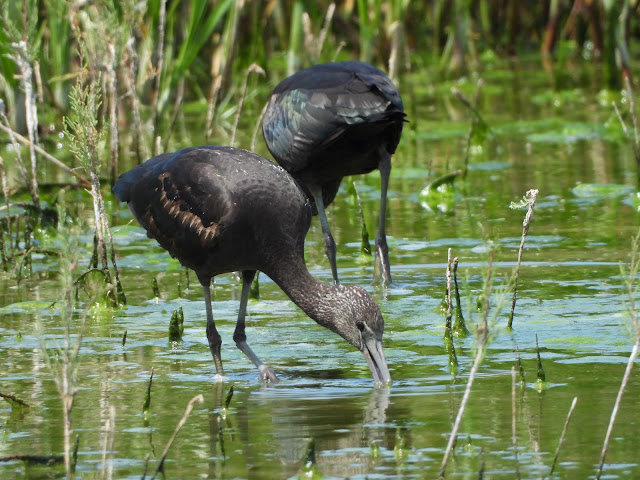Serra de Ronda - Part four and day four
Day four – The Osuna
Triangle.
Peter had so far survived my daft Welsh humour but the day
was young. This steppe area holds an abundance of birds with some real
specialities too, and already we were seeing good numbers of Corn Buntings,
Crested Larks and Turtle Doves. A diversion along a rough track paid off with
the sighting of a Great Bustard taking flight which joined two others at the
edge of a field. Rabbits scurried quickly into the roadside vegetation and
Iberian Grey Shrikes and Spotless Starlings were here and there. A pair of
White Storks had constructed their nest on the top of an electricity pylon and
a Black Kite passed by. At least eight Calandra Larks were counted. Stopping off
on a deserted railway bridge gave commanding views over a salt marsh area which
was being grazed by the local black fighting Bulls. Feeding around the feet of
these animals were Cattle Egrets, Black-winged stilts and Lapwing, and at least
eighty Glossy Ibis were feeding in the damper sections. Also evident were at
least fifty Collard Pratincoles albeit they were quite far out. Scanning across
the scene with his telescope, Peter picked out four Black-bellied Sandgrouse
which had come in to drink, and to our amazement they flew in a little closer,
but they were difficult to find in the camera, but I was lucky to get a half
decent picture of two of them before they flew off again.
Two of the four well camouflaged Black-bellied Sandgrouse.
This was a really good species to see and was to be followed
soon after by a Black-winged Kite perched in the top of an Aloe tree. A pair of
Stone Curlew flew quickly out of sight. We took several different tracks
leading to derelict fincas where a Little Owl was briefly seen, but showing
much better were several pairs of Roller, the blue shimmering in the strong sunlight.
Turtle Doves were seen and more Black Kites and several Common Buzzards were
passing through. A female Marsh Harrier took off from the corner of a field to
our left and then a male Montagu’s Harrier took flight as well.
A Hoopoe called close by but stayed well hidden, and four
Short-toed Larks flew across the field. In a damp patch on a track, several
Spanish Sparrows were drinking, and a nearby old generator housed in a tower
had been converted into a breeding station and was occupied by Spotless
Starlings – and to my amazement, three pairs of Rollers – all of which were
duly flying around the area and showing off their amazing bright blue plumage. After
lunch in a nearby village we visited another Laguna area and watched Grey
Herons close to a breeding colony of Cattle and Little Egrets in the Tamarisks,
Red-crested Pochards, a male White-headed Duck, more Black-necked Grebes,
Glossy Ibis, Black-headed Gulls and two distant Night Herons. A Purple
Gallinule made its way slowly along the base of the Tamarisks. A Great Reed Warbler was in competition with
several Reed Warblers. A second Laguna saw numerous Greater Flamingo’s and
Gull-billed Terns this time with several Whiskered Terns mixed in, Yellow
Wagtails and well over fifty Ringed Plovers with a Little Stint mixed in and
numerous Curlew Sandpipers. A Common Sandpiper and a Greenshank was a nice
little surprise and a pair of Lesser Kestrels circled overhead. On another
track, an Egyptian Mongoose quickly ran from one side to the other, too quick
for a photograph but this was a lifer for me and a lovely little sight. The day was soon over – time really does fly
when you’re having fun, and on the way back to base we watched several more
Montagu’s Harriers and six Collard Pratincoles perched up in a ploughed field.
Glossy Ibis feeding
All pictures copyright of N J Davies






Comments
Post a Comment